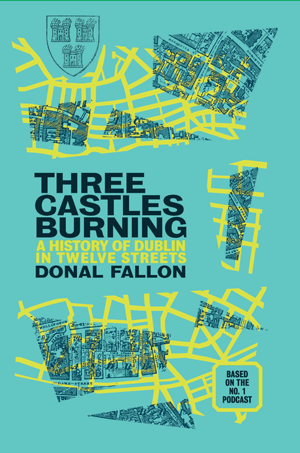DONAL FALLON
New Island Books
€15.95
ISBN 9781848408722
Reviewed by Evan Comerford

Evan Comerford is a civil servant with the Department of Agriculture, Food and the Marine.
Donal Fallon provides a fresh and engaging take on Dublin’s social history with a trip through the streets, broad and narrow, of the capital city in Three castles burning. The book covers similar ground to Fallon’s popular podcast of the same name, telling the story of the city through the people and communities that have shaped it. Covering everything from the Liffey Swim to the uncomfortable relationship between Dubliners and Temple Bar, the book is history from the side-streets and lanes, as well as the main thoroughfares.
With each chapter dedicated to a different street, Three castles burning is akin to a walking tour in book form, pointing out features of the city that are hiding in plain sight. This format allows the author to move seamlessly between eras, from Viking Dublin to the recent past. The vaults of St Michan’s in Church Street and the curve of Fishamble Street towards the Liffey, for example, reveal aspects of a much earlier Dublin that can still be observed today. Bringing it up to modern times, the book also covers the Wood Quay protests of the 1970s, which are now equally part of the history of the Fishamble Street area. Aimed at saving the archaeological remains of Viking Dublin, the protests represented a growing awareness of the civic duty to conserve and protect historic parts of the city from overdevelopment which still has much significance today.
A book on the history of Dublin could easily be dominated by street names, buildings and statues and their connections to the prominent people of the time, but we get a real sense of the ordinary people and communities that have shaped and been shaped by Dublin. The tenements of Henrietta Street, the street traders of Moore Street and Dublin’s infamous red-light district, the Monto, are all familiar parts of the city to us on some level. Fallon gives voice to those communities and adds that extra layer of detail. The chapter on James Joyce Street reveals the exploitative actions of the brothel-owners, or madams, in the Monto but it also includes firsthand testimony from residents, recalling their sympathy for the working girls of the area, and delves into the street’s connection to the Gaelic League revival.
The story of the early twentieth-century Italian migrants in Dublin is another highlight. A small yet influential community formed their own ‘Little Italy’ around the Ship Street area. Some worked as artisans, plasterers and woodworkers, while others were barrel-organ men and street vendors who sold ice-cream. The Cervi family, who arrived in Ship Street in the late nineteenth century, are credited with Dublin’s first chipper. The stories of new migrant communities from China, Vietnam and Africa who have made their homes around Parnell Street and Moore Street since the 1970s are also featured.
Former City Architect Herbert Simms is another influential figure discussed in Three castles burning. His designs for the Emmett Building flats on Watling Street in the 1930s provided modern homes in the inner city for Dublin’s working class. Recent appreciation for Simms’s modernist designs and his progressive views on housing has led to an increased recognition of his impact on the city. As Fallon points out, this probably reflects some of the current debates and frustrations concerning the issue of housing. For all the anecdotes and myth-busting, there is a broader story at play about the changing role of certain streets in the city ecosystem and the forces that shaped those changes. The decline of Dublin as a city of the British Empire after the Act of Union had tangible effects. The once-fashionable townhouses of Henrietta Street were abandoned by the gentry and eventually became the tenements that housed the city’s poor. Dublin’s lack of industrial might, when compared to Belfast or counterpart cities in Britain, meant that poverty and inferior housing were facts of life. The Church Street tenement collapse of 1913 brought Dublin’s housing situation into sharp focus, and its inclusion displays the author’s conscious intent to present an honest account of the difficult aspects of Dublin’s past.
Commerce and local industry had a crucial role in shaping the character of certain parts of Dublin too. In the chapter on Watling Street, we learn about the social status associated with a ‘Guinness man’, who, according to locals, ‘worked with the conscious air of belonging to the world’s largest brewery’. The sustained growth of Guinness during the nineteenth century stands in sharp contrast to the decline of brewing and distilling in the Liberties in that period. Guinness eventually took over other local brewers such as the Phoenix brewery, once owned by Daniel O’Connell Jr, son of the Liberator.
Attention is given here to aspects of Dublin’s history that aren’t discussed elsewhere. Facts and context are added to the anecdotes without sacrificing any of the interesting stuff. At a time when the role and future of the capital city seem to be sources of constant debate, there is surely a role for anything that helps us to learn more about the city itself. If you’ve ever been curious about Dublin’s unique charm, look no further.
